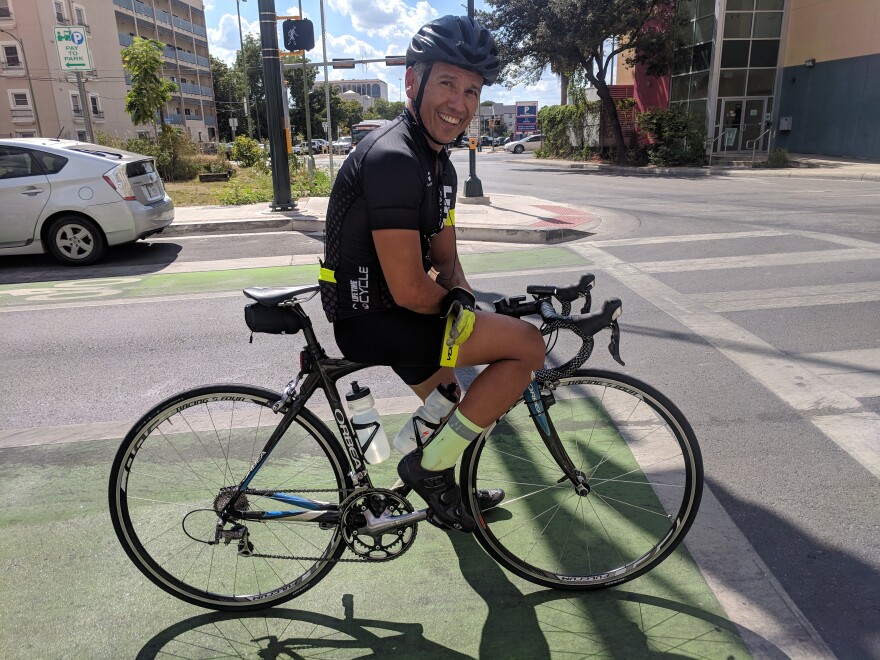Abel Gonzales is on one of his many weekly bike rides downtown. He pulls onto Alamo Plaza road when he spots two 20-something men riding the popular electronic scooters.
“We should follow him,” he says and then pedals off.
As the two men, who are riding in the street, approach the intersection with Houston Street, they shoot across two lanes of traffic onto the sidewalk and back onto the street.
“That’s a classic move,” says Gonzales, who works for San Antonio bike-share company Swell Cycle. “So they’ll go from the street to the sidewalk, to the street,” all to avoid the red light.
Gonzales said it’s fair to say many cyclists don’t like scooters that much.
“It’s hard to find anyone besides a tourist who’ll say they’re not annoying,” he says, following the men on to Houston Street.
As if on cue, the two scooter riders jump from the street back up onto the sidewalk, as two San Antonio policemen on bikes ride by without noticing.
While he doesn’t like scooters, after 30 years of riding across San Antonio’s streets, he loves a good bike lane.
“This is awesome here,” he says, riding up Main Street’s well-marked lanes with sections of bright green, wearing a smile on his face.
“You feel a sense of this is my space and that is the car’s space,” he said.
After a few short blocks, the lane ends and Gonzales is back among the cars.

For years San Antonio has struggled to to build bike lanes and other infrastructure. A 2011 city report said San Antonio had roughly 80 percent fewer bicycle facilities than the average American city.
The past five years the city has spent about $1 million annually on bike lanes, and the city received about $450 million from the 2017 bond for safer streets and sidewalks. Many think their efforts are going in the right direction but few would dispute the city has a long way to go.
To get more bike lanes, cyclists may need to learn to love scooters.
“Even though the city is quite a bit behind as far as bike lanes, this might give them even more incentive,” said Gonzales of the popularity of electric scooters.
Many argue scooter speeds make them a threat to pedestrians on sidewalks, which may prompt new regulations, pushing scooters onto streets. And with more scooters on roadways, city planners nationwide might have to begin rethinking the current car-centric design of many cities.
“Prior to those scooters, those same folks probably weren’t using a bike so there’s more people using other modes,” said Art Reinhardt, assistant director of the city’s Transportation and Capital Improvement department.
Riding in traffic with cars could turn scooter users into advocates for safer lanes, he said.
“The mindset is we need to have safe facilities for things other than cars,” he said.
Bike Texas Executive Director Robin Stallings wants protected bike lane networks in Texas cities. These are lanes that have some physical barrier between cars and cyclists. But he isn’t confident that cities will feel the pressure from scooters to create costly new infrastructure.
“It has the potential to increase pressure,” he said. There is just as likely to create push back to this new technology. So It’s 50/50.”
Scooter companies are working with cities to change how people think about roads.

Bird scooters says it gives a dollar per scooter back to the city each day to help improve streets. Lime partnered with BikeAustin to do traffic safety classes. In an email, Lime officials said they believe their scooters make people more receptive to bike or scooter lanes.
“We reached out to Lime bikes and Jump bikes and they are very supportive of our efforts,” said Janel Sterbentz, who runs the small nonprofit Bike San Antonio. Her organization is circulating a petition for protected lanes on Broadway Street.
At the busy street corner of Houston and St. Mary’s streets, more than two dozen scooters pass over the course of 20 minutes. Nearly all are on the sidewalk.
“I prefer to ride on the street. I can go faster and I don’t have to swerve around people,” said Andrew Flores, who lives downtown and works for USAA, often at their downtown location.
The young, urban professional is what the city has been pushing for to create density downtown. He’s also the target demographic for scooter companies.
Flores worries about safety, and with good reason. Along with roughly 54 cyclists annually ending up in trauma centers in San Antonio, emergency rooms downtown are seeing an uptick in visits by people with scooter-related injuries. According to Baptist’s Dr. Diana Coleman, doctors there see multiple patients per week with mild injuries like sprains and scrapes, but some injuries have been more severe.
“We’ve had people actually have fractures, facial fractures, bleeding in the brain, things that have required transfer to a dedicated trauma center to manage these injuries,” she said.
And seeing more scooters on already crowded streets has Flores concerned.
“I always kind of feel like cyclists have been fighting their own fight for a while. They’ve always been on their own, but I think now with scooters, cyclists have a bigger crowd fighting for those protections of shared space on the streets.”
It is too soon to know how scooters will impact San Antonio roads, but it is clear that it is changing how a lot of people think about safe streets.
Paul Flahive can be reached at Paul@tpr.org or on Twitter @paulflahive




